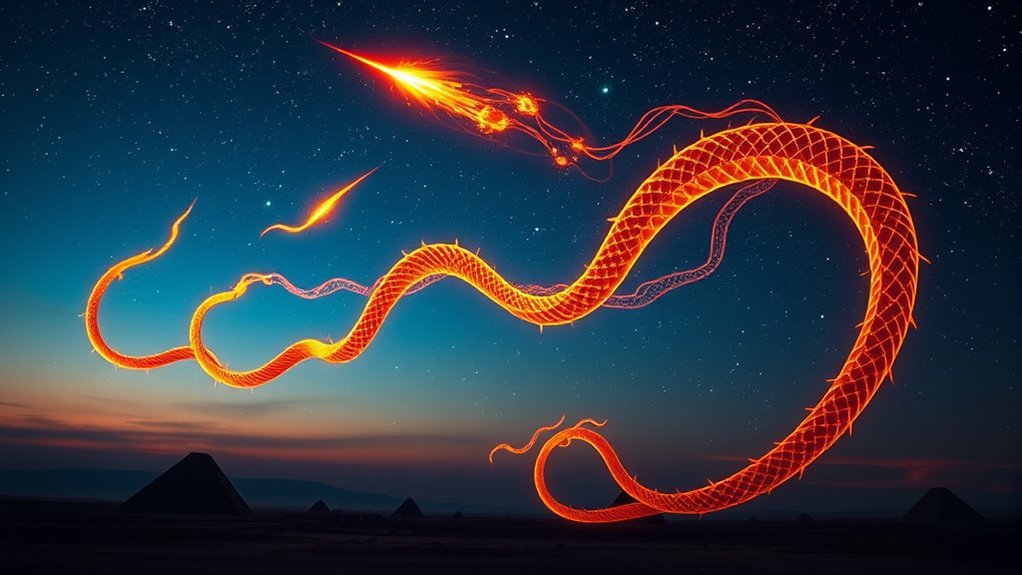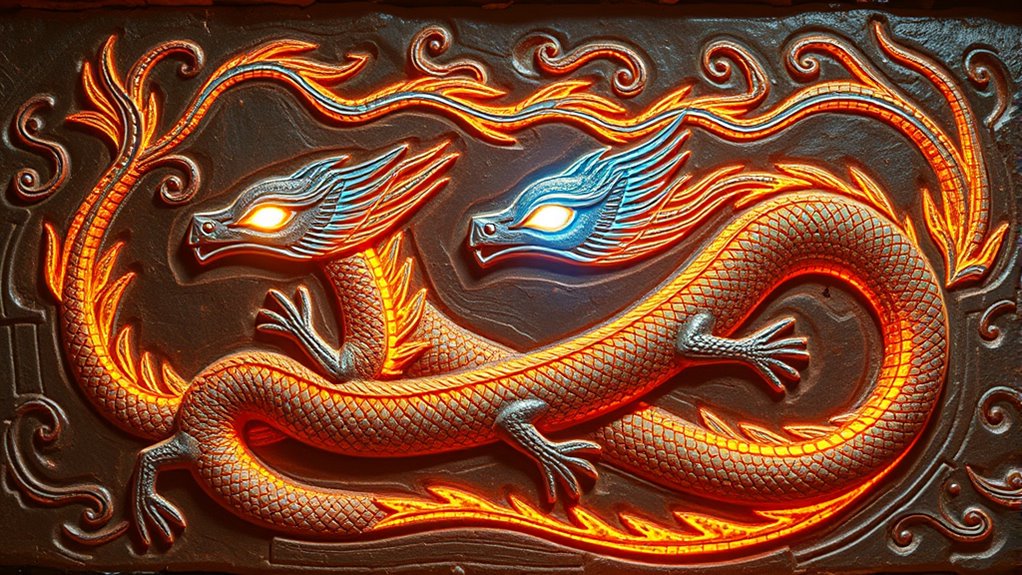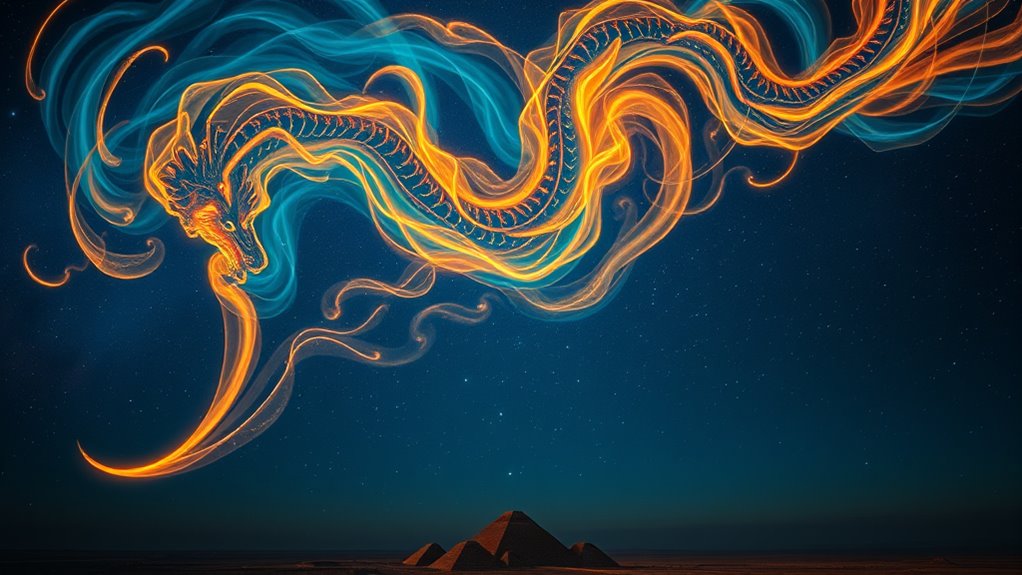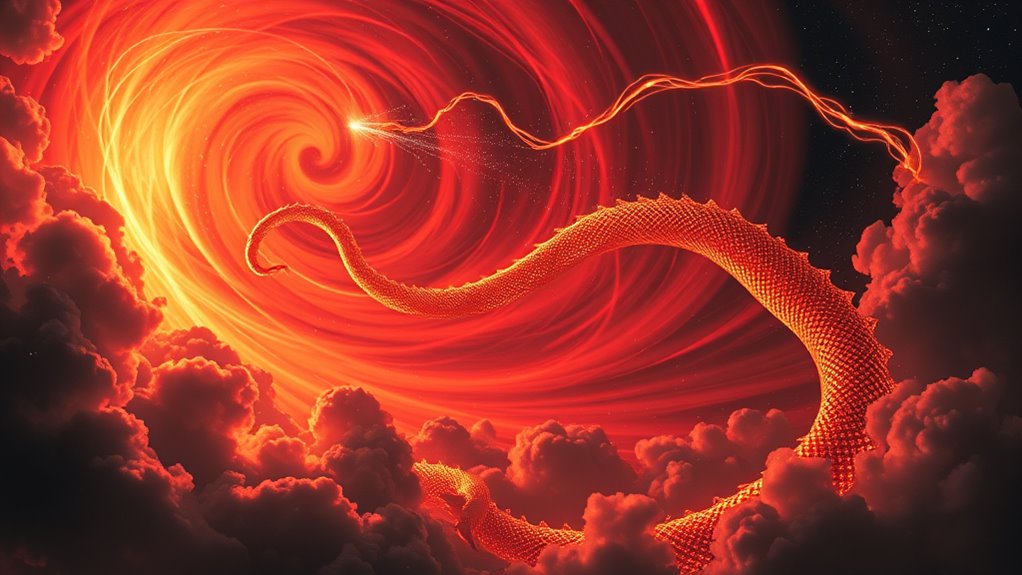Babylonian sky beasts are believed to represent both comets and dragons, reflecting their rich mythological and astronomical symbolism. They are depicted as divine creatures in ancient texts and artifacts, often symbolizing chaos, divine power, and cosmic events like comets or planetary movements. These mythological beings merged celestial phenomena with spiritual beliefs, making them complex symbols. To uncover how these sky beasts embody both natural and mythic worlds, you’ll discover more about their fascinating history.
Key Takeaways
- Babylonian sky beasts often symbolize celestial phenomena like comets, eclipses, and planetary alignments, blending myth and astronomy.
- Artifacts and texts depict creatures resembling both dragons and bright streaks, suggesting they represent a range of sky phenomena.
- Comets were seen as divine signs embodied by mythic creatures, sometimes depicted as dragons or serpents in Babylonian iconography.
- Many sky beasts combine features of dragons and celestial objects, indicating they symbolize both mythological and astronomical entities.
- The dual representation reflects ancient efforts to interpret complex sky events as mythic creatures, encompassing both comets and dragon-like beings.
Babylonian Cosmology and Mythology

Babylonian cosmology and mythology reveal a fascinating view of the universe, where gods and cosmic forces shape the world. You see this clearly through celestial symbolism, which depicts stars, planets, and constellations as divine entities influencing human fate. Mythological creatures play a crucial role, representing both chaos and order in the cosmos. These beings often symbolize powerful forces—dragons, serpents, and winged monsters—embodying the unpredictable nature of the universe. As you explore their stories, you realize that these mythological creatures aren’t just fantastical animals; they embody cosmic principles and divine authority. The Babylonians saw the sky as a sacred domain, filled with symbols and creatures that reflected the intricate relationship between gods, celestial events, and human destiny.
Descriptions of Sky Beasts in Ancient Texts

Ancient texts vividly describe sky beasts as powerful and awe-inspiring entities that embody the forces of the cosmos. These mythological creatures often symbolize celestial symbolism, representing chaos, divine power, or cosmic order. You might encounter descriptions that depict them as:
Ancient legends depict sky beasts as majestic symbols of chaos, divine power, and cosmic harmony across the heavens.
- Fiery dragons with multiple heads, symbolizing chaos and protection.
- Bright streaks or “stars” that move unpredictably, interpreted as celestial omens.
- Serpent-like beings intertwined with constellations, embodying divine forces.
- Giant bird-like creatures soaring across the heavens, signifying celestial messengers.
These vivid descriptions illustrate how ancient civilizations, like the Babylonians, perceived sky beasts—either as literal celestial phenomena or mythological creatures embodying cosmic forces.
Artistic Depictions and Artifacts

Artistic depictions of sky beasts vividly bring to life the mythological figures described in ancient texts, offering a tangible connection to the cosmos as perceived by early civilizations. Through intricate carvings, reliefs, and artifacts, you can observe celestial symbolism that highlights their divine or cosmic significance. These artworks often interpret mythical creatures as celestial signs or omens, blending symbolism with artistic expression. You might notice how the creatures are portrayed with exaggerated features, emphasizing their supernatural power and otherworldliness. Such artifacts serve as visual interpretations of mythological stories, helping you understand how ancient Babylonians visualized sky beasts—whether as dragons, comets, or hybrids—embodying their beliefs about the universe’s mysteries. These representations bridge myth and cosmos, offering insight into ancient celestial symbolism.
Astronomical Records and Phenomena

You can explore how Babylonian cuneiform texts record sky events like eclipses and planetary movements. These ancient writings reveal how they interpreted phenomena that seemed mysterious or powerful. Understanding these records helps us see how they made sense of the universe around them.
Cuneiform Astronomical Texts
Cuneiform astronomical texts serve as a vital window into how early Babylonians observed and recorded celestial phenomena. These clay tablets reveal their understanding of the sky, often linking celestial events to mythological creatures and celestial symbolism. You can find detailed descriptions of unusual lights, planets, and comets, sometimes interpreted as signs from gods or mythic beasts. Notable aspects include:
- Records of planetary movements linked to mythological creatures like dragons and lions.
- Descriptions of bright objects seen as celestial symbols representing gods or monsters.
- Accounts of unusual phenomena, possibly comets, associated with mythic symbolism.
- Use of celestial symbolism to interpret the significance of astronomical events.
These texts reflect the Babylonians’ attempt to understand the sky’s mythic language and its connection to their mythological creatures.
Interpreting Ancient Sky Events
The detailed descriptions found in Babylonian astronomical texts provide more than just records; they reveal how ancient observers made sense of the sky’s mysterious events. They often used celestial symbolism, interpreting unusual phenomena as signs from gods or mythological creatures. Bright streaks or fiery objects could represent dragons or celestial beasts, embodying chaos or divine messages. These interpretations helped people connect cosmic events with their mythology, giving symbolic meaning to comets, meteors, or unusual lights. By understanding these records, you see how sky events weren’t just natural phenomena but stories woven into their worldview. The Babylonians believed these sightings conveyed messages from the heavens, often linked to mythological creatures, shaping their understanding of celestial symbolism and reinforcing their cultural beliefs.
Symbolism and Cultural Significance

Have you ever wondered what the sky beasts represented to the ancient Babylonians? They played a crucial role in shaping astrological symbolism and cultural narratives. These creatures symbolized divine power, cosmic forces, and celestial warnings. To understand their significance, consider:
- They embodied gods’ authority, reinforcing divine rule.
- They served as celestial omens, guiding decisions and rituals.
- They reflected fears and hopes about cosmic stability or chaos.
- They connected humans to the universe’s mysteries through stories passed down generations.
Comparing Sky Beasts to Known Celestial Events

Many sky beasts depicted by the Babylonians can be compared to the spectacular celestial events we observe today, such as comets, eclipses, and planetary alignments. These creatures often symbolize celestial symbolism, representing powerful natural phenomena that inspired awe and fear. For example, a mythological creature might resemble a bright comet streaking across the sky, embodying chaos or divine intervention. Eclipses could be seen as mythological creatures swallowing the sun or moon, signifying upheaval or transformation. Planetary alignments might be interpreted as mythological beasts marking significant cosmic moments. By comparing these sky beasts to known celestial events, you can better understand how the Babylonians viewed the heavens—imbued with mythological creatures that personified the grandeur and mystery of the cosmos.
The Mythical Dragons of Babylonian Lore

In Babylonian lore, mythical dragons embody the powerful forces of chaos and divine authority. These creatures symbolize the cosmic struggle between order and disorder, often appearing in divine narratives to represent chaos that gods must control. Their mythical symbolism includes:
- Guardians of sacred spaces and divine secrets
- Embodiments of chaos threatening cosmic stability
- Symbols of divine power and authority
- Messengers connecting heaven and earth
You see, these dragons aren’t just fierce beasts; they carry deep spiritual meaning. They illustrate how gods maintain cosmic balance, asserting divine dominance over chaos. Their presence in myths reinforces the idea that divine authority involves taming chaos, ensuring order in the universe. As such, Babylonian dragons are central to understanding their divine narratives and mythic worldview.
Modern Interpretations and Scientific Perspectives

Modern interpretations of Babylonian sky beasts blend ancient symbolism with contemporary scientific understanding, offering new insights into their origins and significance. Some researchers view these mythological creatures as representations of alien symbolism, reflecting early human attempts to interpret extraordinary celestial phenomena. Others propose that these sky beasts symbolize mythological creatures inspired by observed astronomical events like comets or meteors, which were seen as divine signs. Scientific perspectives suggest that ancient Babylonians may have encoded their observations of bright, unusual objects in the sky as mythological creatures or dragons, blending cultural stories with real celestial activity. This approach helps us appreciate how ancient civilizations integrated their understanding of the cosmos into myth, creating a rich tapestry of symbolism that continues to intrigue us today.
Connecting Ancient Stories With Contemporary Astronomy

Connecting ancient stories with contemporary astronomy reveals how early civilizations encoded their observations of the night sky into myth and legend. You can see this in how they interpreted planetary alignments, which often signaled important events or seasons. By studying ancient texts, you learn that:
- Celestial navigation helped sailors find their way using star patterns.
- Mythical creatures represented real astronomical phenomena like comets or meteor showers.
- Constellations served as guides for agricultural or ceremonial timing.
- Stories of sky beasts reflect observations of planetary movements and alignments.
These stories weren’t just myths—they encoded essential knowledge about the cosmos. Today, astronomers decode ancient texts to understand how early cultures perceived planetary movements and celestial navigation, bridging myth with scientific insight.
Frequently Asked Questions
How Did Babylonian Sky Beasts Influence Later Mythologies Worldwide?
You see, sky beasts shaped the mythical symbolism in many cultures, inspiring legends of dragons and celestial creatures. They fueled cultural exchange by spreading stories across regions, influencing mythologies worldwide. These celestial symbols became universal symbols of power, chaos, or protection. Their impact endures today, reminding you how ancient beliefs connected different societies through shared imagery, enriching global mythologies and deepening our understanding of humanity’s relationship with the cosmos.
Are There Any Existing Ancient Artifacts Definitively Depicting Sky Beasts?
Imagine discovering ancient carvings that seem to breathe life into mythological creatures. Yes, some artifacts, like intricate ancient carvings and mythological figurines, definitively depict sky beasts. These artifacts serve as snapshots of early beliefs, capturing dragons or celestial beings in stone or clay. Such relics let us glimpse how ancient civilizations visualized the skies, offering tangible links to their mythologies and cosmic understanding.
What Specific Celestial Events Might Have Inspired Sky Beast Legends?
You might notice that celestial alignment and meteor shower patterns often inspired sky beast legends. When planets line up, or shooting stars streak across the sky, ancient people could interpret these events as signs of mighty creatures or dragons. These spectacular phenomena, visible during specific celestial alignments or intense meteor showers, likely fueled stories that depicted sky beasts, blending awe-inspiring natural events with mythic imagination.
Could Sky Beasts Symbolize Natural Disasters or Cosmic Phenomena?
You might see sky beasts as symbols of natural disasters or cosmic phenomena through celestial symbolism and mythological interpretations. These legends often represent powerful forces beyond human control, like storms or celestial events, embodying fears and awe. By interpreting sky beasts mythologically, you understand they reflect humanity’s attempt to explain and personify cosmic chaos, linking natural disasters with divine or supernatural forces in ancient cultures’ stories.
How Do Modern Astronomers Interpret Ancient Sky Beast Descriptions Today?
Like explorers decoding star maps, modern astronomers interpret ancient sky beast descriptions through celestial symbolism and astronomical reinterpretations. You see, these descriptions often reflect real phenomena, such as comets or meteor storms, but are shaped by cultural stories. Today, scientists analyze historical texts, linking myth to science, revealing how ancient sky watchers understood cosmic events. Your curiosity bridges past and present, showing how celestial symbols continue to inspire scientific discovery.
Conclusion
Imagine gazing up at the night sky, where fiery beasts and dragons dance among stars—both myth and reality intertwined. While ancient texts depict sky beasts as divine symbols, modern science reveals comets and meteors flashing like celestial dragons. You see, whether myth or science, these stories paint a vivid picture of humanity’s awe, blending the mystical with the observable. In the end, the sky’s mysteries both inspire and remind us of our timeless quest to understand the universe.










